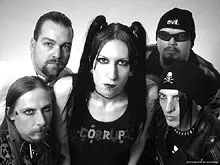
Temple of Misery
Heavy gothic groove. Gothic/Industrial with shades of Punk, Metal, and Synth-pop.
Temple of Misery is a retro goth-rock band changing the shape of the underground music scene by incorporating a vast mix of genre blending old sounds with new. If you must put Temple of Misery into a category, "Heavy Gothic Groove," is most fitting for the band. Heavy Gothic Groove is the niche that the band has carved out for themselves, in which the music sounds exactly as the phrase implies. However, the music is sometimes mellow while other times upbeat, but it always has an edge.
The five-member ensemble's sound has been described as:
"fusing ritualistic tribal percussion with live drumming, apocalyptic Industrial guitar assaults, and dashes of playful punk rock" while "the lead vocals of Lygia soar with a restrained operatic sentiment and instantly require the listener's attention. Exhibiting a wide vocal range and talent, she sheds the soprano for a darker angst-ridden alto that is comparable to the earliest days of Siouxsie Sioux paired with kaRIN of Collide." - (Matthew Heilman - Starvox Music Zine)
The lyrics, influenced by songwriters Tori Amos and Robert Smith, of The Cure, lend a dark poetic quality to the music. Unlike most gothic/industrial bands that employ only drums or synthesizer, Temple of Misery produces a full-bodied wall of sound while weaving both instruments together, giving birth to "a new breed of dark music."
Tell me about your history? How did you get where you are now?
Based in Dayton, Ohio, Temple of Misery was formed in early 2000 by the couple Daniel Rayn, a sampling/sequencing synth player, and Lygia Travesty, a classically trained vocalist. Together, they recruited Odd, a seasoned drummer, who has performed almost all genres of music. A few months later, their friend Merydyan Moore, joined as a guitarist. (As with most bands trying to establish themselves, there have also been numerous line-up changes in Temple of Misery.) Next,they obtained club security guard and friend Cro, to play bass and percussion. It was not until May that Razor, a second guitarist, was added to complete the line-up. In March 2001, Cro left and was replaced by Xerkzies. In June 2002, Razor left and was replaced by Si. Si left in January 2003, returning the band to the original five-piece concept.
The female-fronted band has shared the stage with the likes of big names such as The CruxShadows, Voltaire, Bella Morte, Seraphim Shock, Diva Destruction, Hungry Lucy, and Invisible Records' Meg Lee Chin of the industrial legend, Pigface. Temple of Misery continues to increase its own fan base by bringing new ideas to the stage and making fans wonder what will happen next.
Have you performed live in front of an audience? Any special memories?
We play as much as we can and we're expanding our shows out of state this year.
Your musical influences
We all have different music influences and that's what makes our music different.